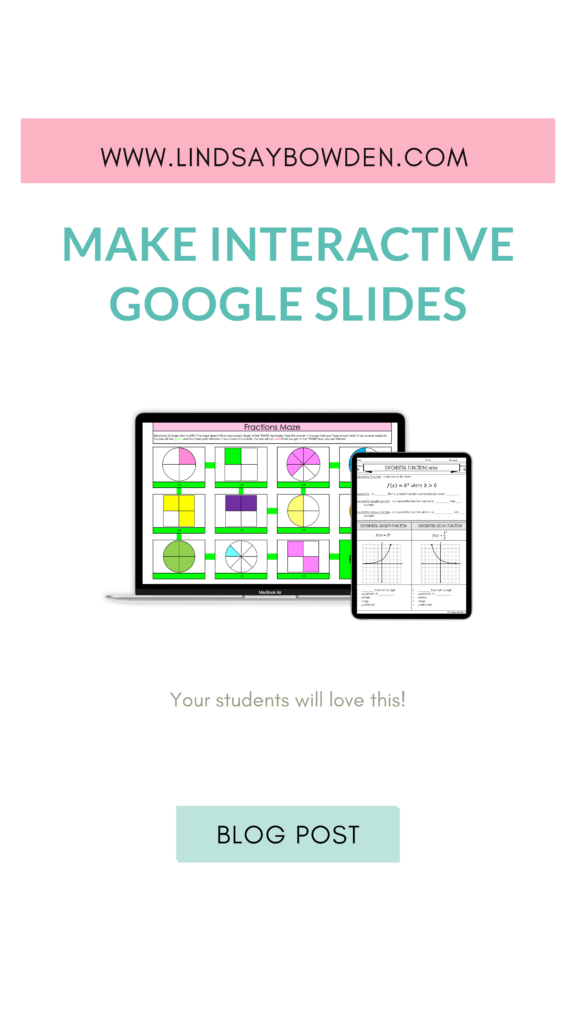
Do you have a ton of amazing interactive resources, but they are all on paper? It is so frustrating and disheartening when you have binders full of amazing resources that you can’t utilize the way you used to. I am here to help you and tell you that you CAN still use them. You can turn your resources digital! I am going to show you how to make interactive Google Slides™.
In this post, I will specifically show you how to create a drag and drop interactive activity utilizing PowerPoint and Google slides.
Step 1: Make PowerPoint Compatable to Google Slides
Open a new PowerPoint presentation. Google Slides automatically has a slide size of 16:9 so make sure that the slide size on PowerPoint is the same. To do this go to “Design” on your top toolbar, click “Slide Size”, and select widescreen. Now it will be the same slide size as Google Slides.
Step 2: Get Background Pictures for Google Slides
Using your PowerPoint presentation, create a directions page and an example page. The example page will show students what the finished product will look like.
Next, you will export both of those slides as pictures so you can use the pictures as the background of your slides in Google Slides.
To do this, you click “File”, then click “Export”, and change file type to PNG. Title the image as what slide it is. For example, the directions slide would be saved as “slide 1” and the example slide would be saved as “slide 2”. Lastly, you want to save the image as the biggest size it can be so the image won’t be blurry. Usually the biggest width is 2000 so change the width of the image to 2000. Then save the images to your desktop.
Step 3: Insert Background Images Into Google Slides
You will next insert your images as backgrounds into your Google Slides. The reason you want the first two slides to be background images is because you do not want students to be able to change the slide or move them in any way.
First, open a new blank presentation in Google Slides and delete all text boxes. Then click “Background” on the toolbar right above the slide. Next, click “Choose Image” and upload “slide 1” from your desktop.
Lastly, duplicate the first slide. Then repeat the process to insert “slide 2” as a background.
Step 4: Set the Background to the Interactive Slides
Insert a new slide by clicking “Slide” and selecting “New Slide”. This will be the first interactive slide on your Google Slides.
Go back to your PowerPoint presentation and look at the next slide. In my activity, the next slide does not have anything on it that students will need to move. Therefore, I am going to save the slide as an image by following the directions we went over above in step 2.
Finally, insert the image as a background on the slide using the directions above in step 3.
Step 5: Create the Moveable Pieces for Google Slides
My activity has moveable drag and drop pieces that will go onto slide 3. To create the moveable pieces on PowerPoint you will insert a shape into your PowerPoint slide and then format it to your desire. For my example, I added a textbox over the shape with needed information and formatted the shape color to fit my activity.
The next step is to save each moveable piece as an image. Before you can save each piece as an image make sure to group the objects that go together in PowerPoint. For example, I grouped the text box and the shape so it is now seen as one object instead of two. To group objects together select all objects, right click, and select group.
Now that all moveable pieces are grouped you will save each moveable piece as an image. Select the moveable piece, right click, and select save as a picture. Save the image as “piece 1” and save it to your desktop. Repeat the process for all of your moveable pieces.
Step 6: Insert Moveable Pieces Into Google Slides
Open the Google Slides activity and go to the slide where you will have your moveable pieces. Drag and drop your moveable piece images from your desktop onto your slides.
You will notice that the pieces are not necessarily the correct size. Therefore, resize the images so that they fit correctly for your activity.
(Pro-tip) Once all of the pieces are the correct size, move them to a different part of the slide and mix them up. You can also change the order of them on the slide by right clicking on them and selecting “bring to front” or “send to back”. This is so that students have to start from the beginning and work their way through the activity without knowing the order that you created it in.
Repeat the process for all of your slides that have drag and drop pieces.
Step 7: Share It With Your Students
Your interactive Google Slides is complete! Now just share it with your students and let the fun begin!
You can share it through a link or on Google Classroom. If you share it with a link, make sure you share it so they can view only or you can share a force copy link.
I hope this tutorial was helpful! Learning how to make interactive Google Slides has been a game changer in terms of engagement for students. Not to mention in years to come the activity will require zero prep!! Do you love creating interactive Google Slides too?! Comment below or tag me on Instagram and let me know!
Head to LindsayBowden.com/Training to sign up for my free training on creating engaging teacher resources!
You may also like:






